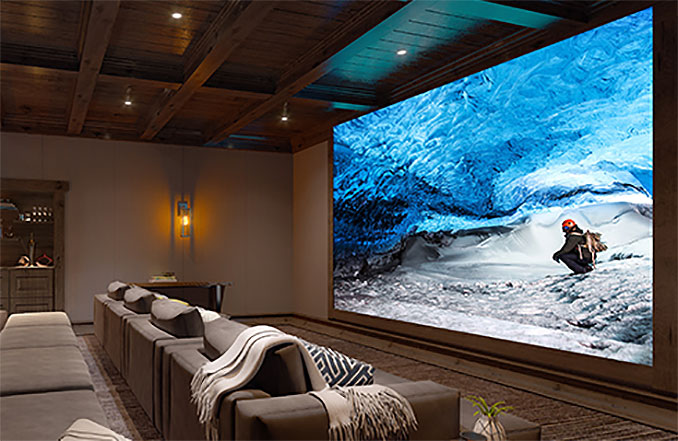Sony’s Micro LED-Based Ultra-HD TVs Available to Consumers: 2K to 16K Resolutions, up to 790-Inches
by Anton Shilov on September 19, 2019 11:00 AM EST
Sony this month started to offer its Micro LED-based displays to well-funded consumers. Officially branded as Crystal LED direct view display systems (aka CLEDIS), these ultra high-end products were previously only available for commercial installations. Designed to offer superior contrasts, brightness levels, and viewing angles, Sony’s Crystal LED TVs are designed to replace projector-enabled home theaters and will be available in 2K, 4K, 8K, and 16K versions with sizes of up to 790 inches.
Sony’s Crystal LED display systems rely on bezel-less Micro LED modules that are built using 0.003-mm² individually-controlled LEDs. The modules offer up to 1000 nits peak brightness, around 1,000,000:1 contrast ratio, up to a 120 Hz refresh rate, as well as nearly 180° viewing angles. According to Sony, such a display can cover 140% of the sRGB color space or around 100% of the DCI-P3 color gamut.
Since the micro LED modules are rather large – even though they're the fraction of the size of a normal LED, the large number of micro LEDs adds up – the size of a Full-HD Crystal LED display system is around 110 inches in diagonal. Meanwhile the 4K unit doubles that, to 220 inches. Since we are dealing with devices that are designed to replace projection-powered home theaters, such sizes are well justified, but they are naturally too large for an average home.
| Sony's Consumer Crystal LED Display Systems | ||||||
| Full HD | 4K | 8K | 16K | |||
| Number of CLED Modules | 18 | 72 | 288 | 576 | ||
| Diagonal | 110-inches | 220-inches | 440-inches | 790-inches | ||
| Dimensions (W×H) | 8 ft × 4 ft 2.43 m × 1.22 m |
16 ft × 9 ft 4.87 × 2.74 |
32 ft × 18 ft 9.75 × 5.48 |
63 ft × 18 ft 19.2 × 5.48 |
||
| Approximate Price of CLEDs at $10,000 per unit | $180,000 | $720,000 | $2,880,000 | $5,760,000 | ||
Sony’s Crystal LED-based display systems for residential installation will be available through a select group of individually trained and certified Sony dealers. The devices will be supported by Sony’s technicians, who will be able to remotely monitor displays after their installations to provide ongoing service.
Sony is not publicly quoting prices for its consumer Crystal LED products, but there are estimates that each module costs around $10,000 per unit. This would mean that a Full-HD version, which consists of 18 modules, costs over $180,000, whereas a 4K system will be priced at over $720,000.
Related Reading:










46 Comments
View All Comments
QinX - Thursday, September 19, 2019 - link
Bold words!damianrobertjones - Thursday, September 19, 2019 - link
...as long as it doesn't get filled with dust, overheat, randomly turn off or the colour wheel (if it uses one) goes nuts and everything looks like a rave. I LOVE projectors... but they come with future issues.DigitalFreak - Friday, September 20, 2019 - link
You could sell the kid and buy the OLED TV with the money. Both problems solved.surt - Thursday, September 19, 2019 - link
This is not for consumers who have to make this or that kinds of choices, but rather 'what next' kind of choices.Shlong - Friday, September 20, 2019 - link
A person buying this can easily afford 25 years of luxury vacations along with the TV, where $5 million isn't that big of a deal. Billionaires.HollyDOL - Friday, September 20, 2019 - link
Yep... so, consumer is what, P99.9 income person? If the article was talking about customers, it would be a different playfield, but consumer seems... quite a bit off.edzieba - Thursday, September 19, 2019 - link
I'd love to see a teardown of one of these modules, and see whether these 'microLEDs' are on a monolithic substrate, CoB like you get in high density illumination modules, or discrete but tiny SMD LEDs using some crazy 00301 RGB package.ballsystemlord - Thursday, September 19, 2019 - link
Cool, but way to expensive. Even a high end TR (inc. peripherals), system would cost less then the Full HD display.Hello5667 - Thursday, September 19, 2019 - link
Even if they weren't so expensive, there are a lot of other issues with these including electricity requirements, heat generated, maintenance, etc... Here is a good article:https://www.projectorcentral.com/the-projectionist...
tuxRoller - Thursday, September 19, 2019 - link
That's not exactly coming from a disinterested 3rd party:)Things to note:
1 - for a given luminance, projectors are less efficient
2 - projectors are not as bright (when including the screen)
3 - projection's contrast is not as good
I'm not claiming there are no downsides, but if (probably when since they have so many benefits and flexibility) the costs of microled modules come down, cinema projectors will be relegated to a similar, not identical, status to current day film.